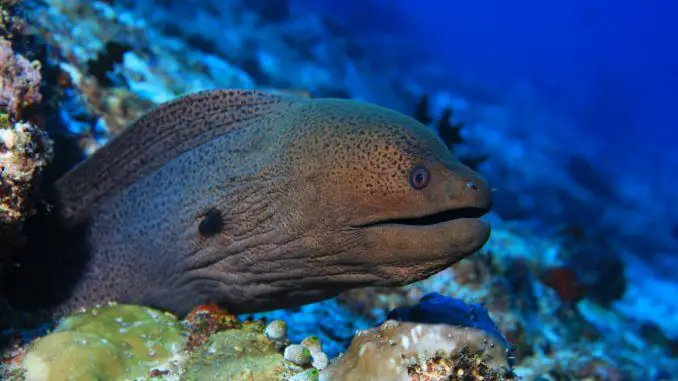
When starting a fish tank, adding a saltwater aquarium eel may not be your first thought. But if you are thinking about making the jump from “classic” fish to something a bit more unorthodox, Morays make a unique alternative.
Moray eels are becoming increasingly popular with experienced fish keepers. The range of different species offers various colors and patterns, so there is always one to suit your style.
Their undulating swimming motion is almost hypnotic and creates a completely different dynamic in your aquarium.
There are so many different species, roughly 200, with each having its own look and personality.
In this guide will talk about saltwater eels, Morays, and give specific examples of the most popular varieties including; snowflake, green, zebra and chainlink Moray eels to name a few.
TABLE OF CONTENTS
Moray Saltwater Eel Facts & Overview
| Category | Rating |
| Care Level: | Moderate |
| Temperament: | Semi-aggressive |
| Color: | Various |
| Lifespan: | 10-30 years |
| Size: | 4.5-156 inches Species dependent |
| Diet: | Carnivore |
| Family: | Muraenidae |
| Minimum Tank Size: | 15-30 gallons. Species dependent |
| Tank Setup: | Marine: corals and crevices |
| Compatibility: | Large, robust fish |
Moray eels, or Muraenidae, are a family of eels in the Anguilliformes family. This family contains 16 genera encompassing approximately 200 species. These eels are saltwater eels with almost 200 species (most of them marine) of which 12 are thought to be suitable for a home aquarium, while only five are considered safe for housing with other fish.
This restricted selection includes two of the most popular species, the Snowflake (Echidna nebulosa) and the Zebra Moray (Gymnomuraena zebra).
Morays can be found across the globe but are almost exclusive to coral reefs in tropical regions. Most are marine but a few species live in brackish waters.
They come in a wide range of varieties. Some species have vibrant colors while others are muted. Some have intricate designs instead of a block color. Some only eat fish while others exclusively eat crustaceans.
Their size and weight differs dramatically between species as well.
There are many misconceptions about saltwater eels due to their snake-like appearance and portrayal on TV, but these are often unjustified.
People tend to think that they are menacing and aggressive creatures because they spend most of their time looking as if they are ready to bite. However, keeping their mouth open allows them to respire, because they are sending water to the gills at the rear of their head.
Additionally, they are commonly thought to be solitary creatures instead of the intelligent, often social animals that they actually are. There is evidence of them hunting together with other fish.
They are hard to buy compared to other, common fish. It is unlikely that you will be able to find any (let alone the species you want) in your local pet store. Instead you will have to look further afield for specialists.
When you find somewhere that sells the species you want, you may have to wait a while as they are not always available. It is hard for a store to maintain stocks because they have to rely on wild caught fish as they are hard to breed in captivity.
Prices will vary depending on the size and species of the Moray you want, as well as where you are buying it from.
Many popular species are $25-$100 but the larger, rarer species can cost you hundreds of dollars.
Appearance
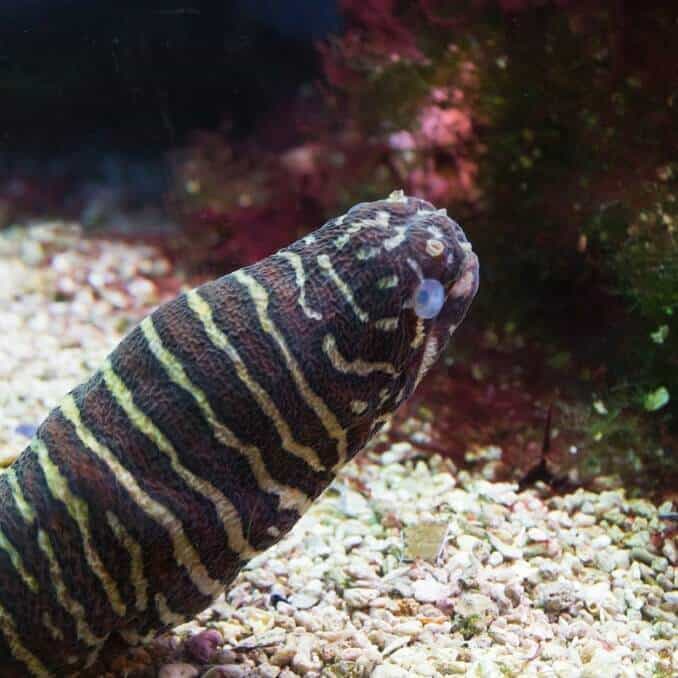
Infamously sinister in appearance, most people can picture a Moray. Having beady eyes, a large mouth, and a long, snake-like form plays a large role in making them one of the most villainized creatures in the ocean.
Most of their body is generally devoid of anatomical structures since most species lack pectoral and pelvic fins. The exception to this is the dorsal fin which runs from the base of the head to the tail where it fuses with the caudal and anal fins.
Scales are also absent, having been replaced by thick, tough skin. Embedded in the skin is an abundance of goblet cells which are used to secrete mucus across the body.
It is virtually impossible to determine the sex of them with the naked eye, making it hard to breed them in captivity.
Interestingly, they are not dependent on eyesight since they have evolved an acute sense of smell to detect prey.
Underneath the eyes is a well-developed mouth, which usually remains open. A narrow head means that Morays are unable to create the pressure required to swallow prey, but this problem is solved with a second set of jaws called the pharyngeal jaws.
The pharyngeal jaws are brought to the front of the mouth to grab prey and pull it into the body.
Gills can be found at the rear of the head, and are usually small and round. They must keep their mouth open to supply the gills with water for respiration.
Since there are roughly 200 species, it can be expected that appearance will vary between them. This is evident through differing sizes, jaw structures, and body patterns.
The winner for longest is the slender giant Moray (Strophidon sathete) reaching 13 feet (4 m), while the smallest, Snyder’s Moray (Anarchias leucurus), is all the way down at 4.5 inches (11.5 cm).
Jaw types tend to change based on diet. Those feeding on crustaceans (such as those from the genus Echidna) have shorter, rounded jaws with molar-like teeth to allow them to break through a hard shell. This is opposed to pointed jaws with longer teeth used to eat fish (such as larger Gymnothorax species).
Many Morays have a distinctive look which makes them easily identifiable. This could be a vibrant color or a striking pattern. A species’ common name usually gives you a good idea of what it looks like.
Below are just a few examples of popular varieties:
Chainlink Moray Eel
Grows up to 30-inch-long, fish-eating eel with black skin covered in yellow stripes.
Giant Moray Eel
Reaching 9.8-feet, this is one of the largest. It is a brown, speckled Moray that mainly feeds on crustaceans.
Green Moray Eel
This eel can look either green or yellow depending on perception. Being 8-foot allows it to eat big fish.
Snowflake Moray Eel
Popular for home aquariums due to its black, white and yellow coloration. When full size this species can reach 39 inches and eats most meaty foods.
Spotted Moray Eel
An attractive variety due to its densely packed spots. This 6 foot Moray eats fish or crustaceans.
Zebra Moray Eel
Contrasting black and white stripes run the length of its 20 inch body. This eel feeds exclusively on crustaceans.
Behavior
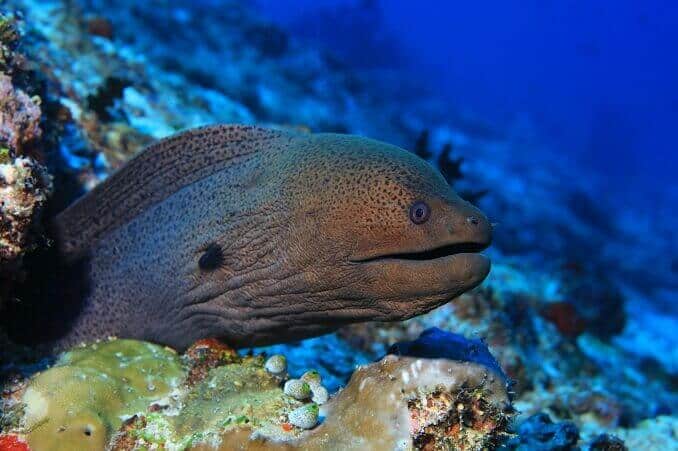
While Morays will add an alternative look to your aquarium, they will also add some interesting and rare behaviors.
Firstly, one of the most iconic behaviors is the way aquarium saltwater eels swim. Their bodies undulate in sinusoidal (S-shaped) waves in order to propel themselves forward.
This adds excellent contrast to “classic” fish that utilize their pectoral (side) or caudal (rear) fins to generate thrust.
Another behavior is to hide between rocks while sticking its head out whilst moving the body beneath. In the wild this is a hunting technique with the aim to ambush their prey.
A stranger hunting technique involves a Moray biting a fish while tying itself in a knot, to improve its grip and power. This is rare and reserved for larger prey.
Usually nocturnal, they will get used to your feeding routine and are still an attractive addition in the daytime.
They secrete mucus to protect themselves from germs and discourage parasites. This may become food for a hungry cleaner wrasse or be used to help sand-dwelling Morays form stronger burrows, as the mucus adheres the sand grains together.
For many species, the mucus they produce contains multiple different toxins, but not in amounts that will harm you or fellow tanks mates.
However, the toxins do explain why a Moray’s bite is more painful than those of other predatory fish of similar sizes.
A common question about morays is whether they are electric. They are not electric but the confusion probably comes from the famous electric eel, though this is actually a freshwater knifefish from South America.
Habitat and Tank Conditions
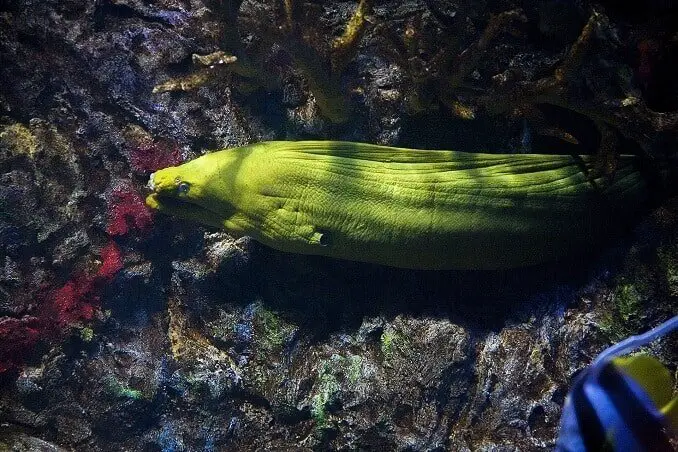
Moray eels are almost exclusively marine and can be found near to the equator, in most tropical regions with coral reefs.
They spend much of their time among small cracks and crevices between corals and rubble. This provides a good idea for what an ideal aquarium should contain.
Corals and rocks are crucial for them to weave themselves between. This will encourage their natural behaviors and keep them happy.
They are stronger than they look and can become particularly active during feeding times, so rocks should be firmly set in place to avoid being knocked down.
With regards to substrate – this is a matter of personal preference. They can produce a lot of waste and therefore many people prefer to keep a bare-bottomed tank, however, a saltwater aquarium eel may like burying itself in the substrate.
If you don’t mind them burying themselves, you can include a layer of sand or very fine gravel and perhaps keep it thin so you can still see them.
Given that their body length can range from 4.5 inches to 13 feet, tank size requirements are going to vary depending on the species.
The largest ones (larger than 10 feet) are rarely kept in the home aquarium due to trouble with providing adequate space. Individuals reaching 2.5 feet or more by adulthood should be kept in at least a 30 gallon tank. “Mini-Morays” (less than 15 inches) will be comfortable in tanks as small as 15 gallons.
It is worth noting that due to the curious nature of Morays, tanks should be fitted with a secure cover with no gaps. Saltwater eels will likely investigate the tank’s exterior given a chance.
A carnivorous diet often results in lots of mess being produced in a short amount of time. Make sure that water changes are conducted every 1-2 weeks to prevent the buildup of nitrogenous waste.
Wet-dry filters and canister filters are two good examples to help maintain a suitable water quality.
The optimal parameters for them is broad. Having no special requirements, they should flourish in most standard marine aquarium setups with a pH between 7.6 and 8.4 and a salinity of 1.022 to 1.025. The same can be said regarding temperature, which should be around 74-79°F.
Tank Mates
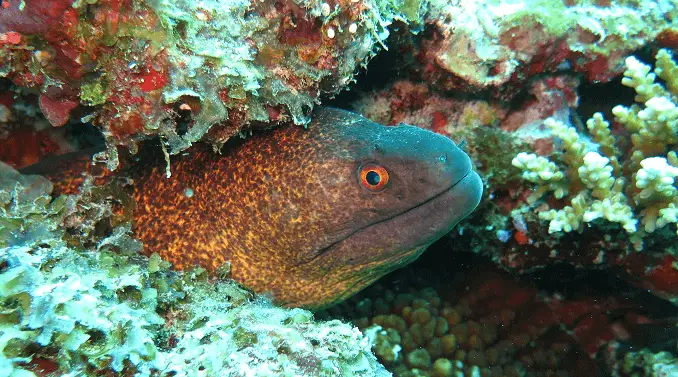
If you want to mix piscivorous eels with fish, make sure the fish were introduced to the tank before the Moray. Most importantly, the fish need to be at least three times larger than the eel’s girth. Groupers can be ideal companions, but you need to bear in mind the size differences.
Cleaner Wrasse are also suitable tank mates. In the wild they are particularly fond of Morays because they produce nutrient-rich slime, and the Wrasse would also pick off parasites.
In an aquarium, Cleaner Wrasse are prone to being eaten so make sure they are introduced to the tank before the eel to reduce the odds of them being viewed as food.
Another popular tank mate for is Lionfish.
You should not keep them with small marine fish because these will be treated as food. Large fish are more suitable, but even adding these is risky.
Generally, they should be kept in a species tank or in a community of large, robust fish. The larger the tank, the less risk to the fish.
Keeping Moray Eels Together
Keeping more than one individual of the same species may result in fighting, especially if one is introduced after the other is already settled.
Fighting occurs due to food or territory disputes, so if you are keeping more than one eel make sure you have a bigger tank with more hiding spots for them to escape each other. If fighting occurs regularly then the perpetrators will have to be separated.
Diet
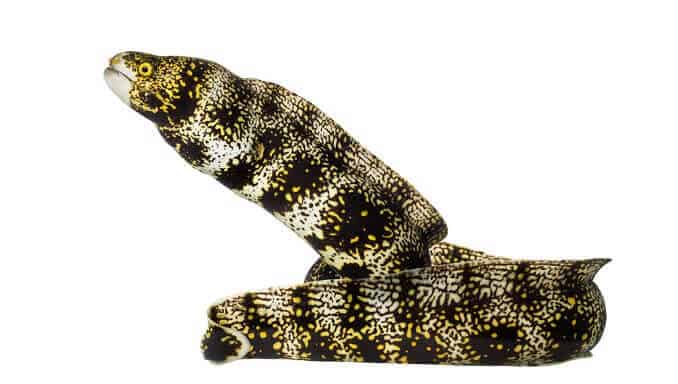
In the wild, eels are a nocturnal ambush predator, but a saltwater aquarium eel will get used to a daytime feeding routine.
Morays are carnivores, but species can be divided between those that eat hard-shelled organisms (durophagous) and those that eat fish (piscivorous). These two groups have the corresponding jaws that were mentioned earlier.
Just like humans, they like a varied diet. This can be done by adding fish or crustacean flesh as well as live food. Live food is particularly entertaining as you get to see your saltwater aquarium eels in hunting mode.
Live food can be difficult to get your hands on in the quantities needed, so we recommend getting them used fresh or frozen food such as crab, squid, and other fish.
Unlike other fish which you can wean onto flake or pellet food, they are very unlikely to eat either of these. Due to their carnivorous nature, they require plenty of meat.
Sometimes they may refuse to eat. This problem is usually due to poor water conditions and can be solved by a water change. Overfeeding is another possible cause.
If water parameters are within their normal range and they are still not eating then you can try varying the food.
It is not uncommon for a newly added one to go on hunger strike for its first few weeks in the tank. The transitional period as the eel gets used to your setup is a stressful time, but if you keep persevering then it should start feeding when settled.
Saltwater eels should not be fed too much or too often, as they will greedily keep on eating, become fat, and may develop liver complications. Feeding twice a week is a common recommendation for most. Each time they should be fed to satiety – where they eat no more.
As previously mentioned, their eyesight is not particularly well-developed. Your hand can easily be mistaken for food, so using tongs to lower food to the eel is a simple way to reduce the risk of an unexpected bite.
They can be kept singly so do not feel that you need to purchase a group.
Care
They are hardy fish and are resistant to most diseases. They are unaffected by Ichthyophthirius multifiliis (Ich) which is one of the most persistent fish diseases.
Most health issues will come from poor water conditions, feeding, or attacks from other fish, but occasionally Morays can suffer from skin lesions or inflammation.
Breeding
It is very difficult to breed them in captivity. The main reason for this is because naturally, a female would mate with a male or several males before releasing her eggs.
The larval stage for Moray eels can then last up to 10 months, which is hard to cater for in an aquarium.
A further problem is that it is difficult to distinguish the sex by eye.
Is the Moray Eel Suitable for your Aquarium?
If you are looking to bring a touch of outlandishness into your home then Morays might be right for you.
Their unique colors and behaviors make them popular choices for experienced keepers, but there are a few things to consider before purchasing.
Morays can be kept alongside other fish, but only if they are large enough. They are most suited to tanks which have plenty of corals and crevices for them to hide in.
One of the most important factors is the size of your tank: can it comfortably accommodate the eel(s) you want?
If, having read this guide, you feel your tank meets the criteria, adding a Moray might be a good choice.
However, make sure to thoroughly research the exact species you want before setting up your aquarium.
Which species of Moray eel would you want in your aquarium? Let us know in the comments section below…

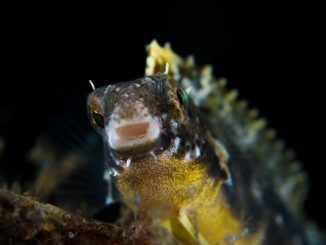
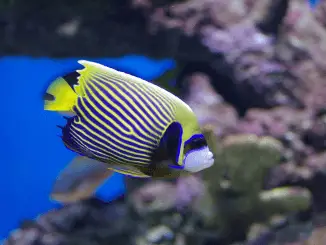
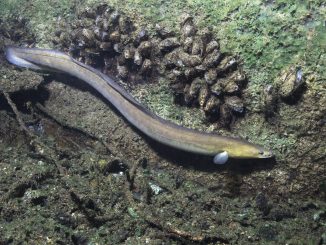
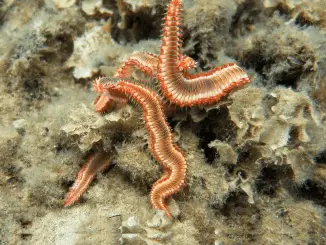
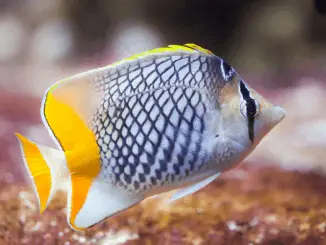
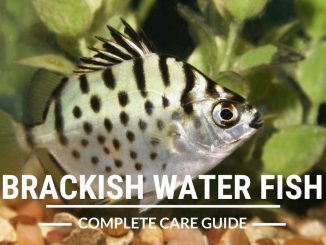
I am planning to build a 250 or larger tank for my zebra moray. I have read that fiberglass decorations are bad for them , does this mean all fiberglass? Or would I be safe building my tank using fiberglass?